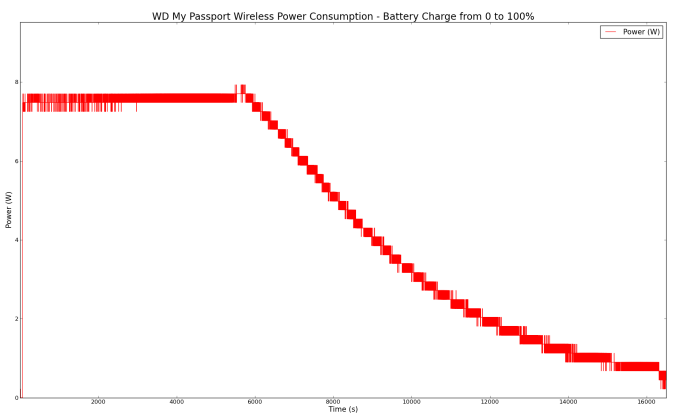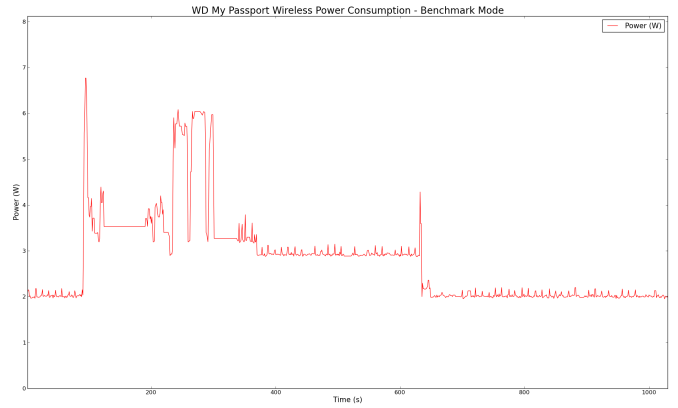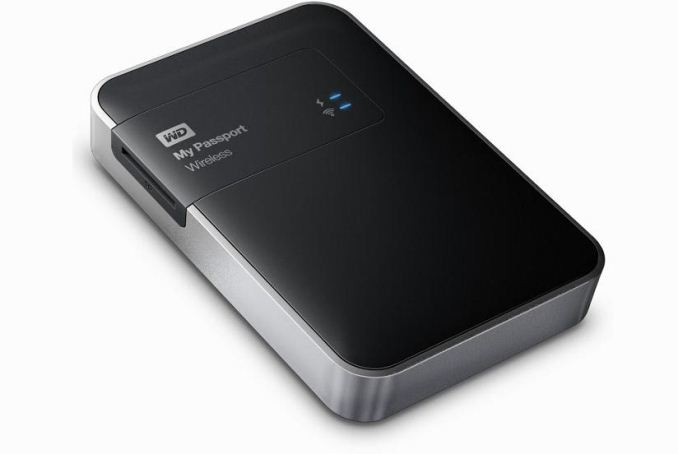Western Digital My Passport Wireless Review
by Ganesh T S on December 3, 2014 4:15 PM EST- Posted in
- Storage
- Gadgets
- Mobile
- wireless storage
Miscellaneous Aspects and Concluding Remarks
Battery life is an important aspect for wireless storage devices. Western Digital claims up to 6 hours of run-time on the battery, but we saw it was close to 5 hours (without actually streaming anything). To get a better idea of the actual power needed to keep the internals running, we connected the drive and its charger to a Ubiquiti mFi mPower unit. In the first pass, we recharged the battery from 0 to 100%. The graph below shows the power consumption at the wall for this process.
We find that the charging process with the supplied charger takes slightly more than 98 minutes to complete. During this period, the power consumption at the wall is around 7.55 W. This closely tracks the mAh rating (3400 mAh) of the Li-Po battery that we saw in the FCC teardown. After the charging process, the unit was switched on. However, with no activity, the drive moves to idle and eventually standby mode. In the standby mode, the power consumption is only 0.5 W.
In the second power graph, we show the behavior during the benchmarking process.
We find that the drive spin-up from idle draws close to 7 W. After that, streaming with disk read-outs consumes around 6 W.
Coming to the business end of the review, it is clear that WD has succeeded in differentiating itself in the crowded wireless storage market. Targeting the photographers with FTP support and a built-in SD card slot (with auto-import capabilities) makes the product stand out. The unit is DLNA certified for those reliant on a media server for their media consumption needs. It also exposes the contents as CIFS shares. Users who want to utilize the unit outside the My Cloud app also have nothing to complain about. Possible areas of improvement include better battery life (either with a higher capacity battery or better firmware) and a more modern Wi-Fi chipset for faster transfers and more reliable streaming of high bitrate content.
The product uses the highest-capacity 2.5" drive currently available. In terms of capacity, the closest competitor is the Seagate Wireless Plus at $200. The My Passport Wireless 2 TB variant currently retails for $220. A $20 premium for the extra features in this multi-purpose wireless storage unit is, in our opinion, completely justified.













23 Comments
View All Comments
ThomasS31 - Wednesday, December 3, 2014 - link
Looks a painfully slow experience... :)ganeshts - Wednesday, December 3, 2014 - link
It is good enough for the target market :) This is not to be treated like a real 'NAS'.ayejay_nz - Wednesday, December 3, 2014 - link
Cool device! I'm looking for something along these lines so that I can back up photos from an SD card on the fly when I'm travelling next year.I just came across the Kingston MobileLite Wireless G2 which might be a cheaper option, it doesn't include local storage but you can plug USB drives into it. The Kingston seems to have a decent battery pack on it as well.
Slash3 - Wednesday, December 3, 2014 - link
You may want to reconsider that, as the performance of the onboard SD reader is apparently abysmal. Unless you have the better part of a workday to spend waiting for a large capacity SD card to copy onto the internal HDD, it is probably best to offload to a small laptop or to use other devices which pair SD readers with USB ports and attaching it to a standard external drive.AT: Any chance you can include a section on the SD card copy performance? For photographers looking for a way to offload SD cards into secondary storage, this would be valuable information on whether or not this device is capable of serving that requirement. Impressions elsewhere seem to be generally unfavorable at best when it comes to this feature.
ganeshts - Thursday, December 4, 2014 - link
I tested out the SD card copy performance with the following setup:Card: Patriot LX Series 8 GB SDHC Class 10 Flash Memory Card PSF8GSDHC10
Contents: 873 photos / videos (mostly photos) from a Nikon Coolpix P7000 Point & Shoot Camera
Total Transfer Size: 7.20 GB
Time Taken for Copy Import : 10 minutes
Average Speed of Import : 12.30 MBps
Average Power Consumption during Import Process : 5.90 W
I am not sure whether the 12.3 MBps limitation is because my SDHC test card is pretty old or it is because of the inherent speed limitation enforced by the SoC's SDIO interface.
Tbonelml - Thursday, December 4, 2014 - link
Class 10 SD cards have a constant transfer rate of 10mbps, that why its class 10, class 6 is 6mbps and so on.hbarnwheeler - Thursday, December 4, 2014 - link
The class designation indicates (minimum) write speed. In this test, the drive is merely reading from the card and read speeds are typically much higher than write speeds.artemisgoldfish - Thursday, December 4, 2014 - link
The AM335x family of CPUs has an MMC interface good for 24MBytes/s in 4-bit high-speed SD card mode. The limitation could be a combination of the Patriot LX series SD cards not being the fastest in the world, the Sitara being busy talking to both the SD card and hard drive, and SD card protocol overhead.Guspaz - Wednesday, December 3, 2014 - link
I got a RavPower 5-in-1 FileHub for $40 that does most of the same stuff this does (except it has no built-in HDD, so you provide your own SD card, USB stick, or USB hard drive). The battery on it lasts somewhat longer than the WD thing. It works pretty well, but the max wireless speed for streaming seems to be about 16 Mbps. I use it to watch videos on my iPhone/iPad using the Infuse app (any app that supports SMB/CIFS would work).jann5s - Thursday, December 4, 2014 - link
For these prices you can also by a cheap laptop/netbook, which will have less disk space, but will have a display and many other useful advantages. When I was searching for an intermediate storage solution for my vacations I found a cheap laptop to be an excellent solution.